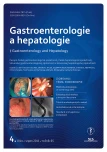Treatment of liver failure caused by Wilson´s disease
Authors:
H. Petrášková; F. Novák; R. Humlová; R. Brůha
Authors‘ workplace:
IV. interní klinika – klinika gastroenterologie a hepatologie, VFN a 1. LF UK v Praze
Published in:
Gastroent Hepatol 2011; 65(4): 220-223
Category:
Hepatology: Case Report
Overview
The treatment of liver failure in a patient with acute manifestation of Wilson´s disease is described in the case report. Twenty-three-year-old female patient was admitted with the decompensation of liver cirrhosis (originally of unknown aetiology) with the sings of liver failure (Child-Pugh C, 12 points). The suspicion to Wilson´s disease was based on a history of the patient and high copper in urine. The diagnosis was confirmed by liver biopsy and subsequently by genetic examination. As the patient was obese with BMI 60, the consideration of liver transplantation was precluded. The patient was stabilized and liver function improved on maximal conservative treatment with concomitant treatment with chelating agents. The first choice penicillamine had to be exchanged for trientine due to allergy reaction and bone marrow suppression. 18 months after treatment initiation the patients is well, completely compensated with Child-Pugh A classification (5 points).
Key words:
cirrhosis – liver failure – penicillamine – trientine – Wilson´s disease
Sources
1. Brůha R, Mareček Z, Martásek P et al. Wilsonova choroba. Čas Lék čes 2009; 148: 544–548.
2. Huster D, Leonhardt K, Mossner J. Wilson disease – update on pathophysiology and management. Čes a Slov Gastroent a Hepatol 2008; 62(4): 220–228.
3. Wiggelinkhuizen M, Tilanus MEC, Bollen CW et al. Systematic review: Clinical efficacy of chelator agents and zinc in the initial treatment of Wilson disease. Aliment Pharmacol Ther 2009; 29(9): 947–958.
4. Ferenci P, Caca K, Loudianos G et al. Diagnosis and phenotypic classification of Wilson disease. Liver Int 2003; 23(3): 139–142.
5. Mareček Z. Wilsonova choroba. Praha: Galén 1996. 143 s.
6. Fink M, Abraham E, Vincent JL et al. Critical Care. Philadelphia: Elsevier Saunders: 2005.
7. Sherlock S, Dooley J (Eds.). Diseases of the Liver and Biliary System. Oxford: Blackwell Science 2004 : 413–420.
Labels
Paediatric gastroenterology Gastroenterology and hepatology SurgeryArticle was published in
Gastroenterology and Hepatology

2011 Issue 4
- Metamizole vs. Tramadol in Postoperative Analgesia
- Current Insights into the Antispasmodic and Analgesic Effects of Metamizole on the Gastrointestinal Tract
- Spasmolytic Effect of Metamizole
- Metamizole at a Glance and in Practice – Effective Non-Opioid Analgesic for All Ages
- The Importance of Limosilactobacillus reuteri in Administration to Diabetics with Gingivitis
Most read in this issue
- Standard of the Czech Society of Gastroenterology for capsule endoscopy of the small intestine
- Autoimmune pancreatitis in a patient with Crohn’s disease
- What to do when invasive colorectal carcinoma is found in endoscopic resection specimens?
- Single-balloon enteroscopy in patients with Crohn’s disease – single centre’s experience
